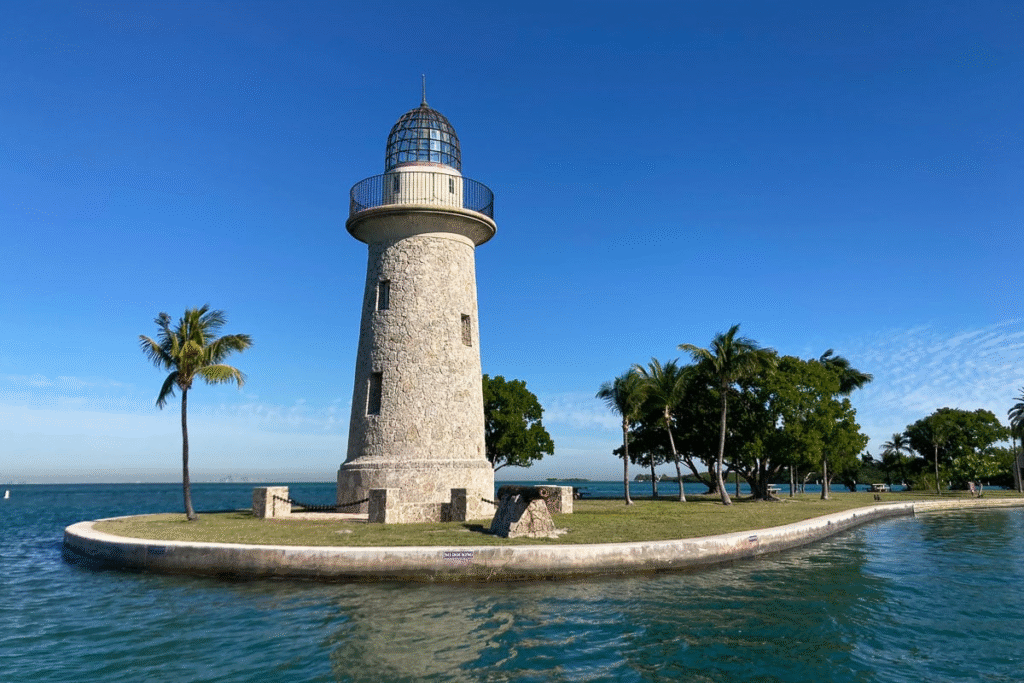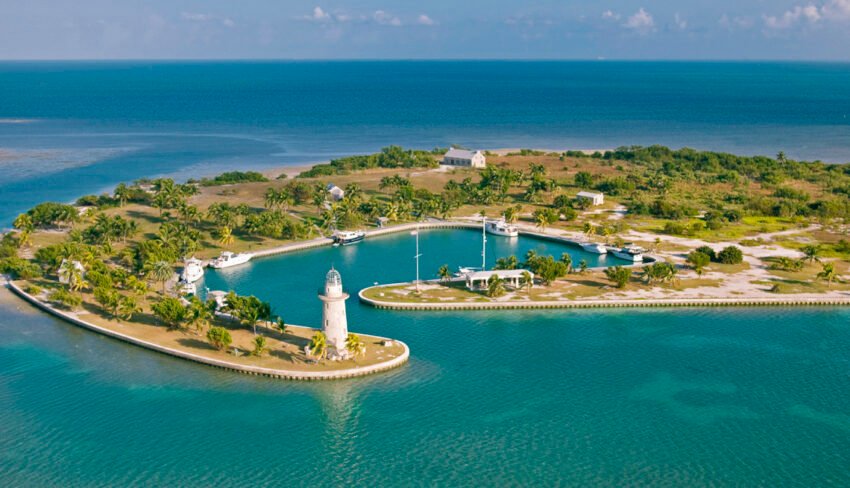Even though it’s just a stone’s throw from one of the biggest cities in the U.S., Biscayne National Park’s wild waters, islands, and mangroves have stayed surprisingly untouched. The park is thriving today—despite plans back in the 1960s to turn it into a sprawling waterfront neighborhood.
Just under 10 miles from downtown Miami (as the seagull flies), the park shelters the northern edge of the Florida Keys and the world’s third-largest coral reef system. When it comes to wildlife diversity, both on land and in the water, this place rivals—and even beats—every other national park.
Boaters drift among the mangroves in Florida’s Biscayne National Park, which provide crucial shelter for animals like the state’s beloved manatees.
About 95% of Biscayne is water—a vast, lagoon-like bay stretching up to eight miles wide—while much of the mainland is dense, tangled mangrove forest. This unique landscape makes it completely different from its famous neighbor, Everglades National Park.
“A lot of people assume that because we’re so close, Biscayne is just like the Everglades,” says Elizabeth Strom, the ranger in charge of Biscayne’s volunteer program. “While we do share some ecosystems and resources, the parks are distinct.” The Everglades is mostly freshwater, while Biscayne is saltwater.
About This Map
Biscayne’s warm subtropical waters are a playground for adventure—whether you’re into canoeing, kayaking, motorboating, sailing, scuba diving, snorkeling, fishing, or paddleboarding. But the fun isn’t just underwater. As a key stop on the Atlantic Flyway, the park is also a paradise for birdwatchers.
Best Views in the Park
For the most stunning view of Miami’s skyline, head to the 65-foot-high Boca Chita Lighthouse, built in 1938. Located on Boca Chita Key, it’s only reachable by boat. The Biscayne National Park Institute (BNPI) offers eco-friendly tours that include stops here, like a half-day heritage cruise ($79 per person) or a full-day sailing and snorkeling trip ($199 per person). Check the NPS website for other authorized operators. Note: At the time of writing, the Boca Chita Key Historic District was under maintenance, so verify closures before booking.

Best Hikes & Water Trails
Hikes:
- Black Point Jetty Trail – Less crowded and great for spotting wildlife (especially birds), this trail starts at the south end of SW 8th Avenue. The round-trip walk takes about an hour, and you can cap it off with lunch or sunset drinks at Black Point Ocean Grill.
- Spite Highway Trail – A 7-mile path on Elliott Key, this is your best shot at seeing the rare Schaus swallowtail butterfly. The trail got its name from disgruntled developers who, in the 1960s, bulldozed a path down the island in protest when the land became a national park. The trailhead is near Elliott Key Campground.
Water Trails:
- Elliott Key Paddling Trail – The most challenging of the park’s kayak routes.
- Crocodile Creek Paddling Trail – A 3.75-mile round trip that winds through narrow mangrove tunnels, offering a close-up look at Biscayne’s wildlife. Both trails launch from the beach near Dante Fascell Visitor Center.
For divers and snorkelers, the Biscayne Maritime Heritage Trail links six shipwrecks—from the 1878 steamship Arratoon Apcar to the 1966 schooner Mandalay—stretching from Key Biscayne to Elliott Key.
Best Wildlife Spotting
Biscayne is home to an incredible mix of creatures: sea turtles, elusive American crocodiles, manatees, bottlenose dolphins, over 600 fish species, and hundreds of birds.
The Biscayne Birding Trail includes 10 prime spots for birdwatching. BNPI’s Jones Lagoon tour takes you to a secluded area known for roseate spoonbills, sea turtles, and even baby sharks.
If you don’t have a boat, BNPI’s snorkel and scuba trips are the best way to see vibrant coral reefs and tropical fish up close.
Family-Friendly Activities
- Convoy Point Jetty Trail – A short, stroller-friendly boardwalk near the visitor center.
- Junior Ranger & Reef Ranger Programs – Kids can explore a “touch table” with corals, bones, and sponges.
- BNPI Guided Tours – Snorkeling, sailing, and paddling adventures for ages 8+ (some for 12+).
Where to Stay
- Camping – The only overnight option is tent camping on Elliott Key or Boca Chita Key (accessible only by boat). Sites are first-come, first-served ($25/night; $35 with boat docking).
- Hotels – Homestead, just 15 minutes from the park, has several options near the turnpike.
Need to Know
- Fishing – A Florida fishing license is required (16+). Some areas are off-limits—check NPS rules.
- Boating – Waters are open 24/7, but review tide and safety guidelines first.
- Car-Free Access – Take the Homestead National Parks Trolley (weekends, Nov–Apr).
- Planning Ahead – Many activities require reservations. Bring bug spray (mosquitoes are fierce!) and reef-safe sunscreen.
Pets?
Service animals are allowed. Pets are permitted only at Convoy Point and Elliott Key (not inside buildings or on Boca Chita Key). They must be leashed (6 ft max), and waste must be cleaned up.
Accessibility
- The visitor center, Convoy Point Jetty Trail, and some boat tours are wheelchair-friendly.
- Free, accessible trolley service runs from Homestead.
Why You Should Visit Biscayne National Park
Even though it’s just a stone’s throw from one of the biggest cities in the U.S., Biscayne National Park’s wild waters, islands, and mangroves have stayed surprisingly untouched. The park is thriving today—despite plans back in the 1960s to turn it into a sprawling waterfront neighborhood.
Just under 10 miles from downtown Miami (as the seagull flies), the park shelters the northern edge of the Florida Keys and the world’s third-largest coral reef system. When it comes to wildlife diversity, both on land and in the water, this place rivals—and even beats—every other national park.
Boaters drift among the mangroves in Florida’s Biscayne National Park, which provide crucial shelter for animals like the state’s beloved manatees.
About 95% of Biscayne is water—a vast, lagoon-like bay stretching up to eight miles wide—while much of the mainland is dense, tangled mangrove forest. This unique landscape makes it completely different from its famous neighbor, Everglades National Park.
“A lot of people assume that because we’re so close, Biscayne is just like the Everglades,” says Elizabeth Strom, the ranger in charge of Biscayne’s volunteer program. “While we do share some ecosystems and resources, the parks are distinct.” The Everglades is mostly freshwater, while Biscayne is saltwater.
About This Map
Biscayne’s warm subtropical waters are a playground for adventure—whether you’re into canoeing, kayaking, motorboating, sailing, scuba diving, snorkeling, fishing, or paddleboarding. But the fun isn’t just underwater. As a key stop on the Atlantic Flyway, the park is also a paradise for birdwatchers.
Best Views in the Park
For the most stunning view of Miami’s skyline, head to the 65-foot-high Boca Chita Lighthouse, built in 1938. Located on Boca Chita Key, it’s only reachable by boat. The Biscayne National Park Institute (BNPI) offers eco-friendly tours that include stops here, like a half-day heritage cruise ($79 per person) or a full-day sailing and snorkeling trip ($199 per person). Check the NPS website for other authorized operators. Note: At the time of writing, the Boca Chita Key Historic District was under maintenance, so verify closures before booking.
Best Hikes & Water Trails
Hikes:
- Black Point Jetty Trail – Less crowded and great for spotting wildlife (especially birds), this trail starts at the south end of SW 8th Avenue. The round-trip walk takes about an hour, and you can cap it off with lunch or sunset drinks at Black Point Ocean Grill.
- Spite Highway Trail – A 7-mile path on Elliott Key, this is your best shot at seeing the rare Schaus swallowtail butterfly. The trail got its name from disgruntled developers who, in the 1960s, bulldozed a path down the island in protest when the land became a national park. The trailhead is near Elliott Key Campground.
Water Trails:
- Elliott Key Paddling Trail – The most challenging of the park’s kayak routes.
- Crocodile Creek Paddling Trail – A 3.75-mile round trip that winds through narrow mangrove tunnels, offering a close-up look at Biscayne’s wildlife. Both trails launch from the beach near Dante Fascell Visitor Center.
For divers and snorkelers, the Biscayne Maritime Heritage Trail links six shipwrecks—from the 1878 steamship Arratoon Apcar to the 1966 schooner Mandalay—stretching from Key Biscayne to Elliott Key.
Best Wildlife Spotting
Biscayne is home to an incredible mix of creatures: sea turtles, elusive American crocodiles, manatees, bottlenose dolphins, over 600 fish species, and hundreds of birds.
The Biscayne Birding Trail includes 10 prime spots for birdwatching. BNPI’s Jones Lagoon tour takes you to a secluded area known for roseate spoonbills, sea turtles, and even baby sharks.
If you don’t have a boat, BNPI’s snorkel and scuba trips are the best way to see vibrant coral reefs and tropical fish up close.
Family-Friendly Activities
- Convoy Point Jetty Trail – A short, stroller-friendly boardwalk near the visitor center.
- Junior Ranger & Reef Ranger Programs – Kids can explore a “touch table” with corals, bones, and sponges.
- BNPI Guided Tours – Snorkeling, sailing, and paddling adventures for ages 8+ (some for 12+).
Where to Stay
- Camping – The only overnight option is tent camping on Elliott Key or Boca Chita Key (accessible only by boat). Sites are first-come, first-served ($25/night; $35 with boat docking).
- Hotels – Homestead, just 15 minutes from the park, has several options near the turnpike.
(How to plan the ultimate camping trip.)
Need to Know
- Fishing – A Florida fishing license is required (16+). Some areas are off-limits—check NPS rules.
- Boating – Waters are open 24/7, but review tide and safety guidelines first.
- Car-Free Access – Take the Homestead National Parks Trolley (weekends, Nov–Apr).
- Planning Ahead – Many activities require reservations. Bring bug spray (mosquitoes are fierce!) and reef-safe sunscreen.
Pets?
Service animals are allowed. Pets are permitted only at Convoy Point and Elliott Key (not inside buildings or on Boca Chita Key). They must be leashed (6 ft max), and waste must be cleaned up.
Accessibility
- The visitor center, Convoy Point Jetty Trail, and some boat tours are wheelchair-friendly.
- Free, accessible trolley service runs from Homestead.
